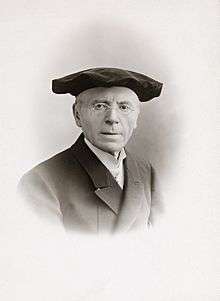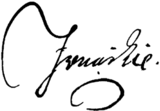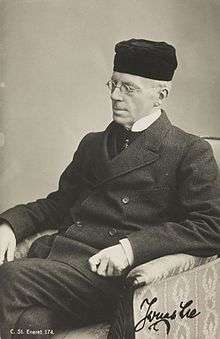Jonas Lie (writer)
| Jonas Lie | |
|---|---|
 | |
| Born |
Jonas Lauritz Idemil Lie 6 November 1833 Hokksund, Eiker, Norway |
| Died |
5 July 1908 (aged 74) Stavern, Larvik, Norway |
| Occupation | Novelist, poet, fairy tales writer, journalist, and lawyer |
| Nationality | Norwegian |
| Literary movement | Realism |
|
| |
| Signature |
 |

Jonas Lauritz Idemil Lie (Norwegian: [liː]; 6 November 1833 – 5 July 1908) was a Norwegian novelist, poet, and playwright who is considered to have been one of the Four Greats of 19th century Norwegian literature, together with Henrik Ibsen, Bjørnstjerne Bjørnson and Alexander Kielland.[1]
Background
Jonas Lie was born at Hokksund in Øvre Eiker, in the county of Buskerud, Norway. Five years after his son's birth, Lie's father was appointed sheriff of Tromsø, which lies within the Arctic Circle, and young Jonas Lie spent six of the most impressionable years of his life at that remote port.[2]
He was sent to the naval school at Fredriksværn; but his defective eyesight caused him to give up a life at sea. He transferred to the Bergen Cathedral School (Bergen katedralskole) in Bergen, and in 1851 entered the University of Christiania, where he made the acquaintance of Ibsen and Bjørnson. He graduated in law in 1857, and shortly afterwards began to practice at Kongsvinger, a town located between Lake Mjøsa and the border with Sweden.[3]
Career
Clients were not numerous at Kongsvinger and Lie found time to write for the newspapers and became a frequent contributor to some of the Christiania journals. His first work was a volume of poems which appeared in 1866 and was not successful. During the four following years he devoted himself almost exclusively to journalism, working hard and without much reward, but acquiring the pen of a ready writer and obtaining command of a style which has proved serviceable in his subsequent career.
In 1870 he published Den Fremsynte ("The Visionary or Pictures From Nordland"), a powerful tale of the sea and northern superstitions. In the following year he revisited Nordland and traveled into Finnmark.
Starting from 1874, the Norwegian Parliament had granted him an artist salary. Having obtained this small pension from the Government, he sought the greatest contrast he could find in Europe to the scenes of his childhood and started for Rome. For a time he lived in North Germany, then he migrated to Bavaria, spending his winters in Paris. In 1882 he visited Norway for a time, but returned to the continent of Europe. His voluntary exile from his native land ended in the spring of 1893, when he settled at Holskogen, near Kristiansand. His works were numerous after that.[4]
Works
In his works, Jonas Lie often sought to reflect in his writings the nature, folk life, and social spirit of the nation of Norway. His writing often dealt with family life in diverse settings, including portraying the social and intellectual restrictions on women of the educated classes. Lie was a versatile writer, liberal and modern, but also strongly tradition bound.
Among Lie's finest works must be considered Familien paa Gilje (" The Family at Gilje: A Domestic Story of the Forties"), which was a striking document of the life of an officer's family, and the few options given to the daughters of such families.[5]
His two collections of short stories called Trold involve the superstitions of the fishermen and coast commoners of northern Norway. The much anthologized short story Elias and the Draugh was included in a collection originally published by Gyldendal Norsk Forlag, and was reprinted by Roald Dahl in Roald Dahl's Book of Ghost Stories (1983).[6]
Personal life
In 1904, the King of Norway awarded Lie with the Grand Cross of the Order of St. Olav. In 1860, he married his cousin Thomasine Henriette Lie (1833–1907). The couple had five children, of whom two died young. Jonas Lie died at Fleskum at Sandvika during 1908, less than a year after the death of Thomasine.
They were the parents of Norwegian author and cultural historian, Erik Lie (1868–1943). Jonas Lie was the uncle of the author Bernt Lie (1868–1916). Henriette Thomasine Lie was the aunt of Jonas Lie, the Norwegian-born American painter.[7]
Works in English translation
- Little Grey (1873, translated by Mrs. Arbuthnott).
- The Pilot and His Wife (1876, translated by Sara Chapman Thorp Bull; and again by G.L. Tottenham, 1877).
- The Barque Future (1879, translated by Sara Chapman Thorp Bull).
- The Commodore's Daughter (1892, translated by H.L. Brækstad and Gertrude Hughes).
- Weird Tales from Northern Seas (1893, translated by R. Nisbet Bain).
- The Visionary (1894, translated by Jessie Muir).
- One of Life's Slaves (1895).
- Niobe (1897, translated by H.L. Brækstad).
- Selected Stories and Poems (1914).
- The Family at Gilje (1920, translated by Samuel Coffin Eastman).
- The Seer & Other Norwegian Stories (1990, translated by Brian Morton & Richard Trevor).
References
- ↑ Jonas Lie (Literature Network)
- ↑ "Jonas Lie - dikterhøvdingen fra Hokksund". eiker.org. Retrieved February 1, 2016.
- ↑ Liukkonen, Petri. "Jonas Lie". Books and Writers (kirjasto.sci.fi). Finland: Kuusankoski Public Library. Archived from the original on March 13, 2012.
- ↑ Jonas Lie – utdypning (Store norske leksikon)
- ↑ Jonas Lie, forfatterside(Dagbladet)
- ↑ Roald Dahl's Book of Ghost Stories (Roald Dahl's Fans.com)
- ↑ Jonas Lie – Norsk Forfatter (Store norske leksikon)
Further reading
- Boyesen, Hjalmar Hjorth (1895). "Jonas Lie." In: Essays on Scandinavian Literature. London: David Nutt, pp. 121–51.
- Jorgenson, Theodore (1933). History of Norwegian Literature. New York: The Macmillan Company.
- Lyngstad, Sverre (1977). Jonas Lie. Boston: Twayne.
- Lyngstad, Sverre (1979). "The Vortex and Related Imagery in Jonas Lie's Fiction," Scandinavian Studies, Vol. 51, No. 3, pp. 211–48.
- Olson, Julius Emil (1920). "Introduction" to The Family at Gilje. New York: The American-Scandinavian Foundation, pp. vii–xxxi.
- Wiehr, Josef (1929). "The Women Characters of Jonas Lie," The Journal of English and Germanic Philology, Vol. 28, No. 1/2, pp. 41–71, 244–62.
External links
| Wikisource has original works written by or about: Jonas Lie |
| Wikimedia Commons has media related to Jonas Lie (writer). |
- Digitized books and manuscripts by Lie in the National Library of Norway
- Works by or about Jonas Lie at Internet Archive
- Works by Jonas Lie at Project Gutenberg
- The Pilot and his Wife by Jonas Lauritz Idemil Lie at Project Gutenberg
- The Visionary by Jonas Lauritz Idemil Lie at Project Gutenberg
- Weird Tales from Northern Seas by Jonas Lauritz Idemil Lie at Project Gutenberg
- Works by Jonas Lie at LibriVox (public domain audiobooks)

- Jonas Lie's texts online (in Norwegian)
- Family genealogy